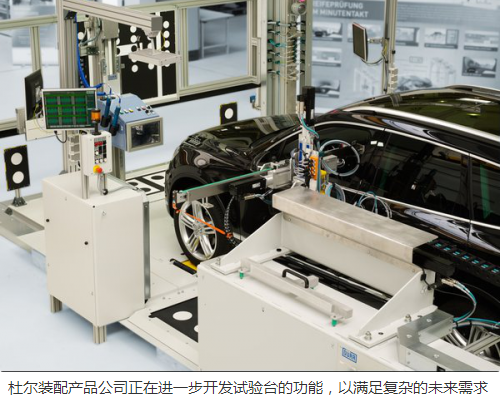On May 1, the "Management Standards for Road Testing of Intelligent Connected Vehicles (Trial)" jointly issued by the Ministry of Industry and Information Technology, the Ministry of Public Security, and the Ministry of Transport came into effect. Recently, Tencent and BMW obtained autonomous driving road test licenses in Shenzhen and Shanghai respectively. The number of companies involved in the field of autonomous driving and countries that have introduced relevant policies and regulations are increasing.
Dürr Assembly Products is currently developing new test bench concepts and expansion and replacement modules to meet future testing tasks. MarTIn Wagner, Autonomous Driving Product Manager of Dürr Assembly Products, pointed out that the testing of autonomous vehicles is a system project. On the one hand, it needs to be compatible with multiple sensors. On the other hand, it also needs to make a new test bench based on the test bench installed by the customer. It is still a decision to upgrade the existing test bed. In other words, R&D companies for autonomous vehicles must also adjust their offline test systems.
It is foreseeable that, in order to ensure the automation or autonomous control of vehicles, more and more information and data from different sensors are integrated and evaluated in real time. Therefore, these systems need to have excellent compatibility, and then the calibration device and test system The overall requirements are also increasing.
MarTIn Wagner also pointed out that for automotive off-line testing, the measurement work needs to be changed significantly. In other words, in addition to the current static sensor calibration, the system also needs to be functionally tested. In addition, more measurement files and adjustment processes are needed so that the correct adjustment can be verified later. "We need a flexible and extensible offline test program. In the future, cars will be able to pass the test bed completely automatically, without any operator for testing, and can be adjusted automatically."
In order to achieve this goal, Dürr Assembly Products is currently intensively developing systems to be provided to customers in the next few years, and regularly communicates with vehicle manufacturers to understand customer requirements for testing processes. At the same time, we are cooperating with universities and driver assistance system suppliers when developing new test bed concepts in order to continuously improve the technology to meet future challenges.

For the future of autonomous driving, MarTIn Wagner is quite optimistic. He believes that some of the functions of autonomous driving have been realized, and the tested vehicles can learn and adjust themselves during use to ensure that they can be used in various environmental conditions and throughout the entire life cycle of the vehicle. The functional stability. However, there is still more to go to achieve fully automated driving. This goal can only be achieved if the vehicle and/or its components are perfectly combined in the assembly process and have been functionally tested. It can be said that the higher the functional and safety requirements of the vehicle, the stricter the requirements for the test system.
Dürr Assembly Products expects to have a highly automated driving system in 2020 that can monitor its own functions and transfer control to the driver when the limit is reached. By 2025, there will be fully autonomous vehicles.
Litecoin (LTC) is a cryptocurrency created as a fork of Bitcoin in 2011. It uses a hashing algorithm called Scrypt that requires specifically designed mining software and hardware. It is minable, and continues to rank in the top cryptocurrencies for value and trading volume.
Litecoin mining is the process of validating transactions in the blockchain, closing the block, and opening a new one. Litecoin uses the proof-of-work consensus mechanism, which uses computational power to solve the nonce, which is part of the hash, that secures the block. The hash is the alphanumeric sequence of numbers that is encrypted by the hashing algorithm. When the nonce is solved, Litecoin is rewarded.
Litecoin mining became popular in 2011 when Charlie Lee, a software engineer at Google, announced its creation as a Bitcoin fork with modifications intended to help it scale more effectively.
Just like Bitcoin, it can be mined on computers using central processing units and graphics processing units. However, it isn't as profitable or competitive as purchasing an application-specific integrated circuit (ASIC) and joining a mining pool.
Ltc Asic Miner,Antminer L3 Plus Plus,Bitmain Antminer L3 Plus,Bitmain L3 Plus
Shenzhen YLHM Technology Co., Ltd. , https://www.hkcryptominer.com